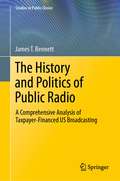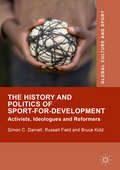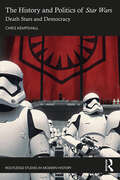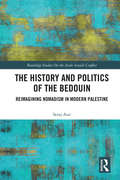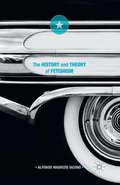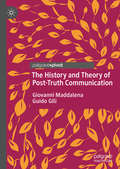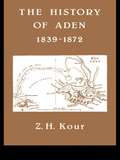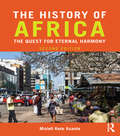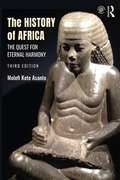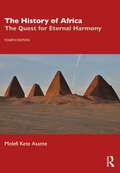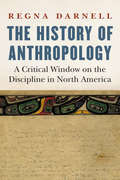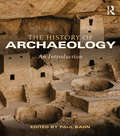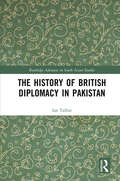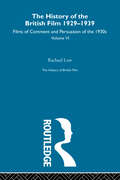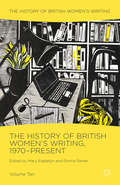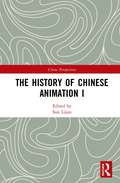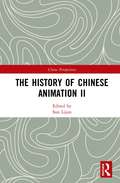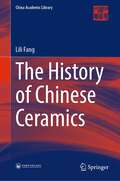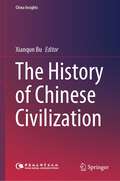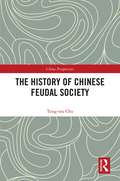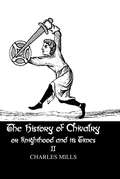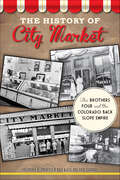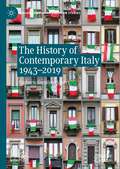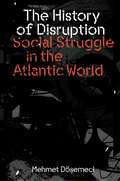- Table View
- List View
The History and Politics of Public Radio: A Comprehensive Analysis of Taxpayer-Financed US Broadcasting (Studies in Public Choice #41)
by James T. BennettThis book presents an absorbing study of how educational radio, which originated to broadcast weather forecasts to farmers, has become what the Pew Center calls the most trusted source of news for American liberals and a regular in the rogue's gallery of election-year conservative targets.The Nielsen Company reported in late 2019 that 272 million Americans listen to "traditional radio" each week, a number exceeding those who watch television, use a smartphone, or access the Internet. Yet almost from the start, radio has also been flayed as a noise box of inanity, a transmitter of low-brow entertainment, an instrument of cultural degradation promoting vapid popular music, and a medium whose ultimate purpose is to convince listeners to purchase the goods and services incessantly hawked by the advertisers who underwrite the programs and allegedly dictate content. At the same time, an alternative conception of radio existed as a vehicle for education and for cultural and intellectual (and even political) enlightenment. Most proponents of this perspective disdained advertising revenue and sought subsidies from foundations, wealthy patrons, or varying levels of government.The long, winding road of educational radio led eventually to the creation of National Public Radio (NPR), a fixture on the left of the dial that can be seen as either the consummation or corruption of the educational radio movement. Prized by many liberals, especially affluent whites, and disparaged by many conservatives, NPR has become a potent symbol of the political polarization and cultural chasm that now characterizes the American conversation.
The History and Politics of Sport-for-Development: Activists, Ideologues and Reformers (Global Culture and Sport Series)
by Bruce Kidd Russell Field Simon C. DarnellThis book focuses on the major social and political forces that have shaped the ways in which sport has been understood, organized, and contested in an effort to engender social change. Integrating the history of international development with the history of modern sport, the authors examine the underpinnings of sport-for-development from the mid-19th through the early 21st centuries. Including both archival research and extensive interviews with more than 15 individuals who were central to the institutions and movements that shaped sport as a force for development, this book will be of particular interest to the growing number of scholars, students, practitioners, advocates and activists interested in the possibilities and limitations of sport-for-development.
The History and Politics of Star Wars: Death Stars and Democracy (Routledge Studies in Modern History)
by Chris KempshallThis book provides the first detailed and comprehensive examination of all the materials making up the Star Wars franchise relating to the portrayal and representation of real-world history and politics. Drawing on a variety of sources, including films, published interviews with directors and actors, novels, comics, and computer games, this volume explores the ways in which historical and contemporary events have been repurposed within Star Wars. It focuses on key themes such as fascism and the Galactic Empire, the failures of democracy, the portrayal of warfare, the morality of the Jedi, and the representations of sex, gender, and race. Through these themes, this study highlights the impacts of the fall of the Soviet Union, the War on Terror, and the failures of the United Nations upon the ‘galaxy far, far away’. By analysing and understanding these events and their portrayal within Star Wars, it shows how the most popular media franchise in existence aims to speak about wider contemporary events and issues. The History and Politics of Star Wars is useful for upper-level undergraduates, postgraduates, and scholars of a variety of disciplines such as transmedia studies, science fiction, cultural studies, and world history and politics in the twentieth and twenty-first centuries.
The History and Politics of the Bedouin: Reimagining Nomadism in Modern Palestine (Routledge Studies on the Arab-Israeli Conflict)
by Seraj AssiThis book examines contending visions on nomadism in modern Palestine, with a special focus on the British Mandate period. Extending from the late Ottoman period to the founding of the State of Israel, it highlights both ruptures and continuities with the Ottoman past and the Israeli present, to prove that nomadism was not invented by the British or the Zionists, but is the shared legacy of Ottoman, British, Zionist, Palestinian, and most recently, Israeli attitudes to the Bedouin of Palestine. <P><P> Drawing on primary sources in Arabic and Hebrew, the book shows how native conceptions of nomadism have been reconstructed by colonial and national elites into new legal taxonomies rooted in modern European theories and praxis. By undertaking a comparative approach, it maintains that the introduction of these taxonomies transformed not only native Palestinian perceptions of nomadism, but perceptions that characterized early Zionist literature. The book breaks away from the Arab/Jewish duality by offering a comparative and relational study of the main forces operating under the Mandate: British colonialism, Labor Zionism, and Arab nationalism. Special attention is paid to the British side, which covers the first three chapters. Each chapter represents a formative stage of British colonial enterprise in Palestine, extending from the late Ottoman down to the postwar and the Mandate periods. A major theme is the nexus of race and ethnography reshaping British perceptions of the Bedouin of Palestine before and during the early phases of the Mandate, and the ways these perceptions guided the administrative division of the country along newly demarcated racial boundaries. <P><P> Using an interdisciplinary approach that combines new findings in the fields of history, ethnic studies, postcolonial theory, and environmental studies, this book contributes to understandings of the Israel/ Palestine conflict, and current trends of displacement in the Middle East.
The History and Theory of Fetishism (Marx, Engels, and Marxisms)
by Alfonso Maurizio IaconoThe History and Theory of Fetishism, the expanded version of Iacono's enduring classic Teorie del feticismo and available for the first time in English, aims to provide the historical context necessary to understanding the concept of "fetishism" and offers an overview of the ideologies, prejudices, and critical senses that shaped the Western observer's view of otherness and of his own world. Iacono examines the moment when the Western observer turned his colonizing and evangelizing gaze to continents such as Africa and the Americas, while attempting to simultaneously destabilize and look at his own world critically.
The History and Theory of Post-Truth Communication
by Giovanni Maddalena Guido GiliThis book traces the principal roots of the concept of post-truth to uncover how it came by its present meaning. The concept of post-truth is the ripe and poisonous fruit of a tree fertilized and watered by many gardeners: some with good intentions, some with bad intentions, and others without a full understanding of the consequences of their thoughts and actions. If the concepts behind the expression ‘post-truth’ have a long history, what is behind the current rise in interest and alarm about the concept? Chosen by the Oxford English Dictionary as ‘word of the year’ in 2016, post-truth has entered both journalistic and common languages. There is, however, much confusion and a suffocating rhetoric about what it is, how it became such a powerful force, and its positive or perverse effects. Offering a fast-paced discussion of philosophical concepts, sociological theories, communication strategies, and original interpretations of historical events from the birth of mass media until today, this book is a guide for those who want to understand what is going on in Western society and culture.
The History of "Zero Tolerance" in American Public Schooling
by Judith KafkaThrough a case study of the Los Angeles city school district from the 1950s through the 1970s, Judith Kafka explores the intersection of race, politics, and the bureaucratic organization of schooling. Kafka argues that control over discipline became increasingly centralized in the second half of the twentieth century in response to pressures exerted by teachers, parents, students, principals, and local politicians - often at different historical moments, and for different purposes. Kafka demonstrates that the racial inequities produced by today's school discipline policies were not inevitable, nor are they immutable.
The History of Aden
by Dr Z Kour Z.H. KourFirst Published in 1980. Routledge is an imprint of Taylor & Francis, an informa company.
The History of Africa: The Quest for Eternal Harmony
by Molefi Kete AsanteThere is a paradox about Africa: it remains a subject that attracts considerable attention yet rarely is there a full appreciation of its complexity. African historiography has typically consisted of writing Africa for Europe--instead of writing Africa for itself, as itself, from its own perspectives. The History of Africa redresses this by letting the perspectives of Africans themselves take center stage. Authoritative and comprehensive, this book provides a wide-ranging history of Africa from earliest prehistory to the present day--using the cultural, social, political, and economic lenses of Africa as instruments to illuminate the ordinary lives of Africans. The result is a fresh survey that includes a wealth of indigenous ideas, African concepts, and traditional outlooks that have escaped the writing of African history in the West. The new edition includes information on the Arab Spring, the rise of FrancAfrica, the presence of the Chinese in Africa, and the birth of South Sudan. The chapters go up to the present day, addressing US President Barack Obama's policies toward Africa. A new companion website provides students and scholars of Africa with access to a wealth of supporting resources for each chapter, including images, video and audio clips, and links to sites for further research. This straightforward, illustrated, and factual text allows the reader to access the major developments, personalities, and events on the African continent. This groundbreaking survey is an indispensable guide to African history.
The History of Africa: The Quest for Eternal Harmony
by Molefi Kete AsanteAuthoritative and comprehensive, The History of Africa provides an accessible narrative from earliest prehistory to the present day, with unusual attention paid to the ordinary lives of Africans. This survey includes a wealth of indigenous ideas, African concepts, and traditional outlooks that have escaped the writing of African history in the West. The fully updated new edition includes information on the recent conflicts in Libya and the Sudan, as well as additional content on the experiences and contributions of women. A companion website offers a wealth of supporting resources for each chapter, including new historic maps, primary sources, video and audio clips, and links to sites for further research. Richly illustrated and clearly written, this volume is an indispensable introduction to the major developments, personalities, and events that have shaped the history of the African continent.
The History of Africa: The Quest for Eternal Harmony
by Molefi Kete AsanteThe new edition of this comprehensive survey of African history provides an accessible overview of the continent’s narrative, focusing on the autonomy and achievements of the African people. The book brings readers closer to an authentic Africa by paying close attention to the lives of everyday people and highlighting insights and ideas that are often missed in typical survey texts. The fourth edition offers expanded coverage of smaller linguistic and ethnic groups in Africa in order to provide a more inclusive history, noting a few individual groups while also analyzing their contributions to the overall narrative and African culture. Liberia’s hidden history is given greater attention in this updated volume, as well as the ethnic and religious tensions in Nigeria and Sudan. While the book emphasizes that African history is always being made, the fourth edition brings the record up to date and grapples with contemporary issues in culture and politics. The History of Africa is an indispensable text for students and researchers in African history, cultural studies, philosophy, and politics.
The History of Anthropology: A Critical Window on the Discipline in North America (Critical Studies in the History of Anthropology)
by Regna DarnellIn The History of Anthropology Regna Darnell offers a critical reexamination of the Americanist tradition centered around the figure of Franz Boas and the professionalization of anthropology as an academic discipline in the late nineteenth and early twentieth centuries. Focused on researchers often known as the Boasians, The History of Anthropology reveals the theoretical schools, institutions, and social networks of scholars and fieldworkers primarily interested in the anthropology and ethnography of North American Indigenous peoples. Darnell&’s fifty-year career entails seminal writings in the history of anthropology&’s four fields: cultural anthropology, ethnography, linguistics, and physical anthropology. Leading researchers, theorists, and fieldwork subjects include Edward Sapir, Daniel Brinton, Mary Haas, Franz Boas, Leonard Bloomfield, Benjamin Lee Whorf, Stanley Newman, and A. Irving Hallowell, as well as the professionalization of anthropology, the development of American folklore scholarship, theories of Indigenous languages, Southwest ethnographic research, Indigenous ceremonialism, text traditions, and anthropology&’s forays into contemporary public intellectual debates.The History of Anthropology is the essential volume for scholars, undergraduates, and graduate students to enter into the history of the Americanist tradition and its legacies, alternating historicism and presentism to contextualize anthropology&’s historical and contemporary relevance and legacies.
The History of Archaeology: An Introduction
by Paul BahnThe History of Archaeology: An Introduction provides global coverage with chapters devoted to particular regions of the world. The regional approach allows readers to understand the similarities and differences in the history of and approach to archaeology in various parts of the world. Each chapter is written by a specialist scholar with experience of the region concerned. Thus the book focuses on the earliest beginnings of archaeology in different parts of the world, and how it developed from being a pastime for antiquarians and collectors to a serious attempt to obtain information about past societies. Woven into the text are various boxes that explore key archaeologists, sites and important discoveries in the history of archaeology enriching the story of the discipline’s development. With such far ranging coverage, including an exploration of the little covered development of Russian and Chinese archaeology, The History of Archaeology is the perfect introduction to the history of archaeology for the interested reader and student alike.
The History of British Diplomacy in Pakistan (Routledge Advances in South Asian Studies #37)
by Ian TalbotThis book is the first account of the British diplomatic mission in Pakistan from its foundation at the end of the Raj in 1947 to the ‘War on Terror’. Drawing on original documents and interviews with participants, this book highlights key events and personalities as well as the influence and perspectives of individual diplomats previously not explored. The book demonstrates that the period witnessed immense changes in Britain’s standing in the world and in the international history of South Asia to show that Britain maintained a diplomatic influence out of proportion to its economic and military strength. The author suggests that Britain’s impact stemmed from colonial era ties of influence with bureaucrats, politicians and army heads which were sustained by the growth of a Pakistani Diaspora in Britain. Additionally, the book illustrates that America’s relationship with Pakistan was transactional as opposed to Britain’s, which was based on ties of sentiment as, from the mid-1950s, the United States was more able than Britain to give Pakistan the financial, military and diplomatic support it desired. A unique and timely analysis of the British diplomatic mission in Pakistan in the decades after independence, this book will be of interest to academics working in the fields of South Asian History and Politics, International Relations, British and American Diplomacy and Security Studies, Cold War Politics and History and Area Studies.
The History of British Film (Volume 6): The History of the British Film 1929 - 1939: Films of Comment and Persuasion of the 1930's
by Rachael LowThis set is one of the cornerstones of film scholarship, and one of the most important works on twentieth century British culture. Published between 1948 and 1985, the volumes document all aspects of film making in Britain from its origins in 1896 to 1939.Rachael Low pioneered the interpretation of films in their context, arguing that to understand films it was necessary to establish their context. Her seven volumes are an object lesson in meticulous research, lucid analysis and accessible style, and have become the benchmark in film history.
The History of British Women's Writing, 1970-Present: Volume Ten (History of British Women's Writing)
by Mary Eagleton Emma ParkerThis book maps the most active and vibrant period in the history of British women's writing. Examining changes and continuities in fiction, poetry, drama, and journalism, as well as women's engagement with a range of literary and popular genres, the essays in this volume highlight the range and diversity of women's writing since 1970.
The History of Chinese Animation I (China Perspectives)
by Sun LijunChina has been one of the first countries to develop its own aesthetic for dynamic images and to create animation films with distinctive characteristics. In recent years, however, and subject to the influence of Western and Japanese animation, the Chinese animation industry has experienced several new stages of development, prompting the question as to where animation in China is heading in the future. This book describes the history, present and future of China’s animation industry. The author divides the business’s 95-year history into six periods and analyses each of these from an historical, aesthetic, and artistic perspective. In addition, the book focuses on representative works; themes; directions; artistic styles; techniques; industrial development; government support policies; business models; the nurturing of education and talent; broadcasting systems and animation. Scholars and students who are interested in the history of Chinese animation will benefit from this book and it will appeal additionally to readers interested in Chinese film studies.
The History of Chinese Animation II (China Perspectives)
by Sun LijunChina has been one of the first countries to develop its own aesthetic for dynamic images and to create animation films with distinctive characteristics. In recent years, however, and subject to the influence of Western and Japanese animation, the Chinese animation industry has experienced several new stages of development, prompting the question as to where animation in China is heading in the future. This book describes the history, present and future of China’s animation industry. The author divides the business’s 95-year history into six periods and analyses each of these from an historical, aesthetic, and artistic perspective. In addition, the book focuses on representative works, themes, directions, artistic styles, techniques, industrial development, government support policies, business models, the nurturing of education and talent, broadcasting systems, and animation. Scholars and students who are interested in the history of Chinese animation will benefit from this book and it will appeal additionally to readers interested in Chinese film studies.
The History of Chinese Ceramics (China Academic Library)
by Lili FangAdopting the perspective of anthropology of art and combining it with global academic insights, this book helps the readers to recognize that “history is, in great measure, the record of human activity which spreads from the local to the regional, from the regional to the global, and from the global to the universal.” Readers will learn that China was not only the first country to create porcelain, but also the first to export it to the world, both the products and its techniques. Therefore, the history of Chinese ceramics reflects the history of Chinese foreign trade on the one hand and depicts the expansion of Chinese ceramic techniques and cultures on the other. In addition to ceramics types, molds, decoration, and techniques, the book analyzes the spiritual impacts and aesthetic conceptions embodied in the utensils of daily use by the Chinese literati. Therefore, it reaches the conclusion that ideological systems and not technological systems are what bring about social revolutions. In addition, the book is richly illustrated with pictures of earthenware and finely glazed pieces from later periods.
The History of Chinese Civilization (China Insights)
by Xianqun BuThis book tracks the entire history of Chinese civilization from a broad historical view. Its narrative spans a long period between primitive society and contemporary civilization, which makes it a unique academic works.From an academic point of view, this book is accurate in history and combines historical theories. Although brief, it captures the main thrust of the development of Chinese civilization and achieves a broad outline. Important figures, historical events, and achievements of civilization in all times are involved and discussed.From a theoretical point of view, based on the characteristics of early Chinese civilization, the book discusses the connotation of key concepts such as "civilization" and "Chinese civilization", which have certain theoretical value.From a contemporary and practical perspective, the book helps readers understand the history of Chinese civilization and promotes cultural exchanges between China and the world and leads to a better understanding of today’s China.
The History of Chinese Feudal Society (China Perspectives)
by Tung-tsu ChuFeudalism is one of the most studied topics in the field of history but without a consensus on its central characteristics, it remains a slippery concept. The History of Chinese Feudal Society provides a comprehensive analysis on the rise and fall of feudalism in China. Drawing on a vast resource of archival materials, it is the first study to investigate feudalism in China from the perspective of sociology and to compare feudalism in China to feudalism in the West. The author proposes that land ownership and the relationship between land owners and farmers are the two determining factors of feudalism with the Yin Dynasty marking a transitional stage to feudalism while the Zhou Dynasty saw the establishment of feudalism as a political system and central institution. This book was written by one of the best-known Chinese historians and has been a classic best-seller for decades. Students and scholars of Chinese history, especially Chinese feudalism, will find it to be an essential reference in their study and research.
The History of Chivalry or Knighthood and Its Times: Volume II
by MillsFirst published in 2005. Routledge is an imprint of Taylor & Francis, an informa company.
The History of City Market: The Brothers Four and the Colorado Back Slope Empire (Landmarks)
by Anthony F. PrinsterCity Market's story begins with a penniless eighteen-year-old immigrant and closes with the business becoming part of the largest supermarket chain in the United States. In 1924, brothers Paul, Frank, Leo and Clarence Prinster bought a meat market in Grand Junction, Colorado, a business venture that would allow them to ride out the stock market crash and the Great Depression. It also allowed them to open the state's first supermarket in 1939, the beginning of an empire that remained in the family for over a century and helped shape the heritage of western Colorado. Tony Prinster shares how the City Market founders and its dedicated employees transformed a family business into the retail brand that touched the lives of so many people.
The History of Contemporary Italy 1943-2019 (Italian and Italian American Studies)
by Umberto Gentiloni SilveriThis book offers a history of contemporary Italy from the collapse of Mussolini to the present, placing this major Euro-Mediterranean country in a wider geo-political perspective. It examines how Italian history and politics developed in relation to - and were shaped by - the international context, from the Cold War and NATO to the European integration process and the global challenges of 1989. Umberto Gentiloni Silveri highlights all major events, structural limits, contradictions and conflicts influencing Italian democracy and the political system until today. He explores the continuous tension between 'stabilization' and 'conflict', between the promise of an innovative and evolutionary representative democracy on the one hand and the constraints of a political system conditioned by structural limits and old contradictions on the other.
The History of Disruption: Social Struggle in the Atlantic World
by Mehmet DosemeciChallenging our understanding of social struggles as movements, Mehmet Dösemeci traces a 300-year counter-history of struggle predicated on disruptionWhy do we think of social struggles as movements? Have struggles been practiced otherwise, not as motion but as interruption, occupation, disturbance, arrest? Looking at three hundred years of Atlantic social struggle kinetically, Mehmet Dösemeci questions the axiomatic association that academics and activists have made between modern social struggles and the category of movement. Dösemeci argues that this movement politics has privileged some forms of historical struggle while obscuring others and, perhaps more damningly, reveals the complicity of social movements in the very forces they oppose.Dösemeci&’s story begins with the eighteenth-century establishment of a transatlantic regime of movement that coerced goods and bodies into violent and ceaseless motion. He then details the long history of resistance to this regime, interweaving disparate social struggles such as food riots, Caribbean maroon communities, Atlantic pirates, secret societies and syndicalism, the student New Left, Black Power, radical feminism, Operaismo, and the Zapatistas into a history of politics as disruption. Dösemeci convincingly argues that this history is key to understanding the resurgence of disruptive politics in the twenty-first century and offers valuable guidance for future struggles seeking to overturn an ever-intensifying regime of movement.
